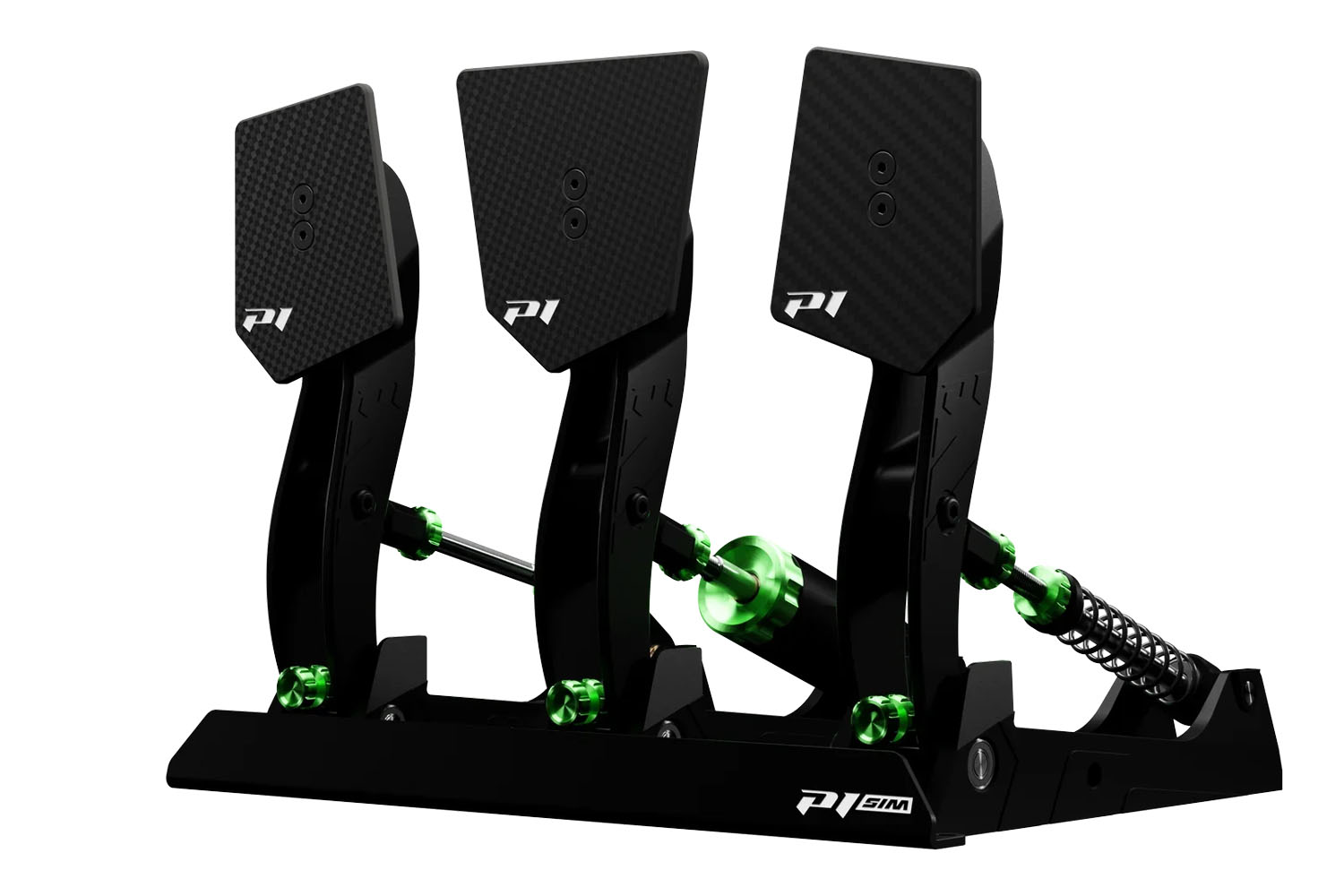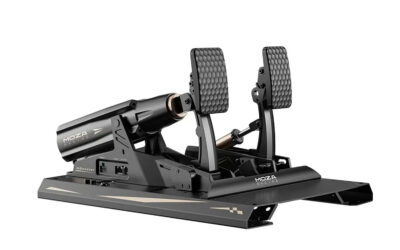P1Sim Mistral
Benefits
- Available with 2 or 3 pedals
- Excellent race feedback
- Haptic feedback on gas pedal and brake
- Fully adjustable pedals (hardware and software)
Disadvantages
- Not much, apart from a haptic feedback that makes a bit of noise
Our rating : 9.7/10
The sim-racing industry seems to have no shortage of brands and players, especially those focusing on the high-end market. Every now and then, a new brand emerges to compete with the industry heavyweights. In the mainstream segment, i.e. brands for the masses, this may prove difficult to achieve, as players such as Fanatec, Simagic and Moza have been in the game for some time. It can be done if you offer competitive prices and, above all, innovative products.
At the top end of the market, well, it can work, as it’s a fairly small market. The example I can give you is that of a small French company, P1SIM, which offers hand-crafted sim-racing peripherals aimed at the premium segment, and even higher.
Among the products sold on the brand’s website is the Mistral crankset. On paper, it’s a model with 2 or 3 pedals, a HALL sensor on the gas pedal, a 200 kg Load Cell on the brake and a clutch that resembles the gas pedal. In what follows, I’m going to introduce you to this pedalboard and tell you what it’s like on a sim-racing rig.
Main features and technical specifications of the crankset
- All-metal construction, from the pedal plate to the frame, including all resistance systems (gas pedal, brake and clutch)
- Load Cell on brake with 200 kg resistance
- HALL sensor on gas pedal
- All aspects of the pedals can be adjusted
- PC and Simhub compatible by adding a plug-in
- Available in a range of colors for crankset components
- Haptic feedback on brake and gas pedal
- Individual pedals for a position of your choice on a chassis, and the possibility of installing them on a plate sold by P1SIM.
Design
The Mistral’s design can be summed up in a single word: magnificent. I often find, and say, that a lot of sim-racing products are beautiful, but the Mistral really sets the bar very high compared to the competition. I don’t know if it’s the design, or the color customization elements you can choose from, but it’s really very beautiful. In fact, I think it’s the only sim-racing product, pedalboard at least, where you have several colors available, if I’m not being silly of course.
Three overall colors are offered: full matte black, full glossy black, and glossy black with white or very light gray pedals depending on the light. It’s beautiful, but not flashy, unless you take the purple elements of course. When you see it for the first time, you’ll think it’s a product taken from a racing car, and that’s what the company claims on its website: “Thought up by real racing engineers and developed with real drivers”.
Customized assembly
The Mistral can be mounted in two different ways: either directly on the cockpit, or on the base plate, or bracket if you prefer. Fixing the pedals uses two screws that go directly onto a frame or base plate, with the screws and bolts supplied with the Mistral. All you need is the right tools for the job.
However, I must inform you of one thing: the baseplate fastening is not standard to suit solutions already on the market, except on aluminum profile. If you have a tubular frame, you’ll almost certainly have to drill the plate to align the screw holes. It’s a bit of a shame, I must say, but at the same time, P1SIM only saw the light of day in 2022, and I’m thinking that the company should put things right in time.
Manufacturing and finishing
On this point, the “very premium” was emphasized at all the meetings. For the price, you get metal, metal and nothing but metal. The build quality is well above what you’ll find in the Mistral segment, and by a good margin. All parts are hand-assembled, according to the brand’s website, with the utmost attention to detail.
Whether it’s the structure of the pedal components, the bearings, the springs or the screws, everything is magnificent and very premium. When launching into sim-racing to compete with popular brands, it was essential to offer a quality product, and P1SIM and its Mistral have won the day.
Pedal settings
Since we have independent pedals, the settings are superb on their location on the chassis or baseplate. You can play with the spacing as you see fit, head up, head down, symmetrical, asymmetrical, etc. And that’s just for their mounting. And that’s just for mounting them.
Once in place, you can change pedal inclination, spring resistance (except for the clutch, which is standard), pedal angle, and everything in between. It’s really very advanced, and it had to be, otherwise the Mistral wouldn’t be able to find takers in a sim-racing market populated by fierce competitors.
And that’s just the mechanical part of the settings. This crankset is Simhub-compatible via a specific plugin that takes the configuration and parameterization aspect even further. Basically, you can do everything via software, from calibration and pedal curves to haptic feedback on brake and throttle. As I said, it’s complete, and it had to be, otherwise why take a chance with such a young brand?
Sensations during play
Let’s move on to the subject we’re most interested in with the Mistral: feel. To cut a long story short, it’s an excellent crankset for sim-racing, especially coming from the first jet of a company fresh off the market.
In terms of riding comfort, I fell under the Mistral’s spell for the simple reason that this crankset offers a wide range of pedal adjustments. From inclination, to spacing, to spring travel and hardness, absolutely everything is adjustable, allowing you to have a crankset suited to all sim-racing situations. Whether it’s GT, F1 or chill driving, the Mistral is perfect in any cockpit.
As for the brake pedal – and let’s be clear, this is the most important of the lot – the different elastomers supplied with the Mistral each offer a specific level of resistance. And coupled with the pedal settings, both hardware and software, you’ll quickly find you’re happy with a precise pedal, providing realistic sensations. What’s more, the Mistral is equipped with haptic feedback on the brake and throttle, which is excellent for an extra dose of realism when ABS, traction control or simply loss of grip intervenes. Honestly, haptic feedback should be fitted to all high-end cranksets, it’s a game changer as far as I’m concerned.
Compatibility
Not surprisingly, the Mistral is only compatible with PCs running Windows 10 and 11. For virtual drivers who don’t want to give up Windows 7, it may be time to upgrade, or risk missing out on a unique experience with this pedalboard.
As far as sim-racing titles are concerned, the list is long and includes AC, ACC, iRacing, rFactor and more. It’s comprehensive, and you shouldn’t have any problems with compatibility, or even detection, as long as you have a recent machine and an up-to-date title.
Also, as I mentioned above, the Mistral is supported by Simhub by installing the specific pedalboard plugin.
Value for money
The Mistral starts at €649 in 2-pedal configuration, and costs €899 if you take it with the clutch. It’s expensive, yes, but at the same time, it’s premium and high-performance. I’d say that its value for money, compared with the competition from Simagic,Asetek Simsports or other brands, makes it great, especially in terms of feel.
My verdict
The Mistral is a superb top-of-the-range crankset that wants to carve out a share of the sim-racing market against brands that are well established in the segment. And given the feel, design and build quality of this crankset, I’d have to say it’s got a good chance.
For PC gamers, I’d recommend it without the slightest hesitation, especially if you’re shopping between €700 and €900.










0 Comments